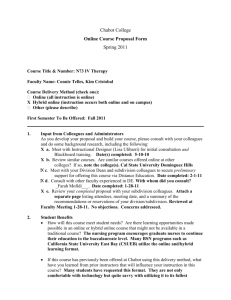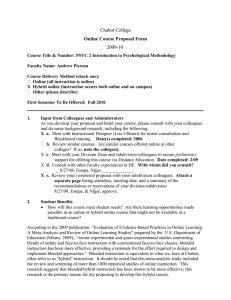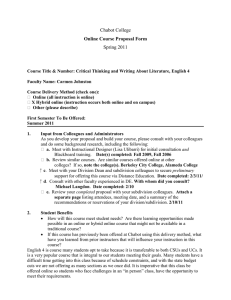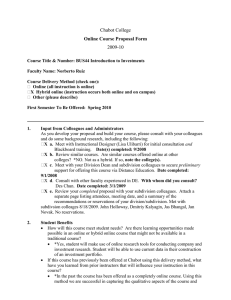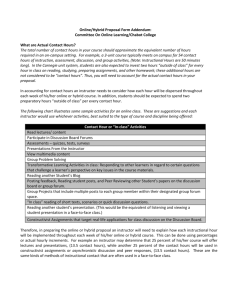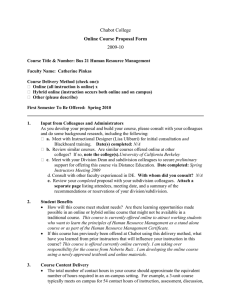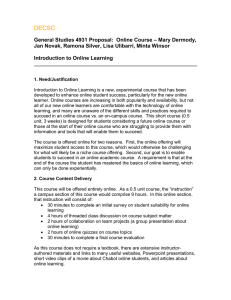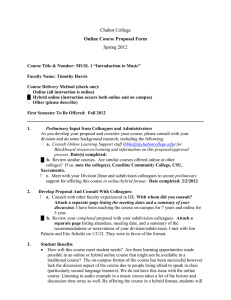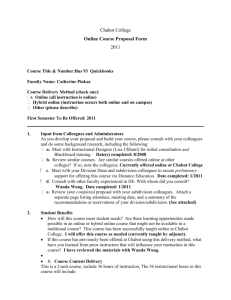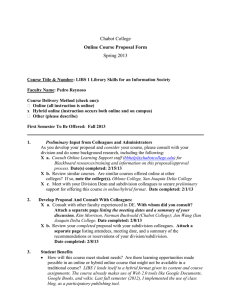Chabot College 2009-10 Online Course Proposal Form
advertisement
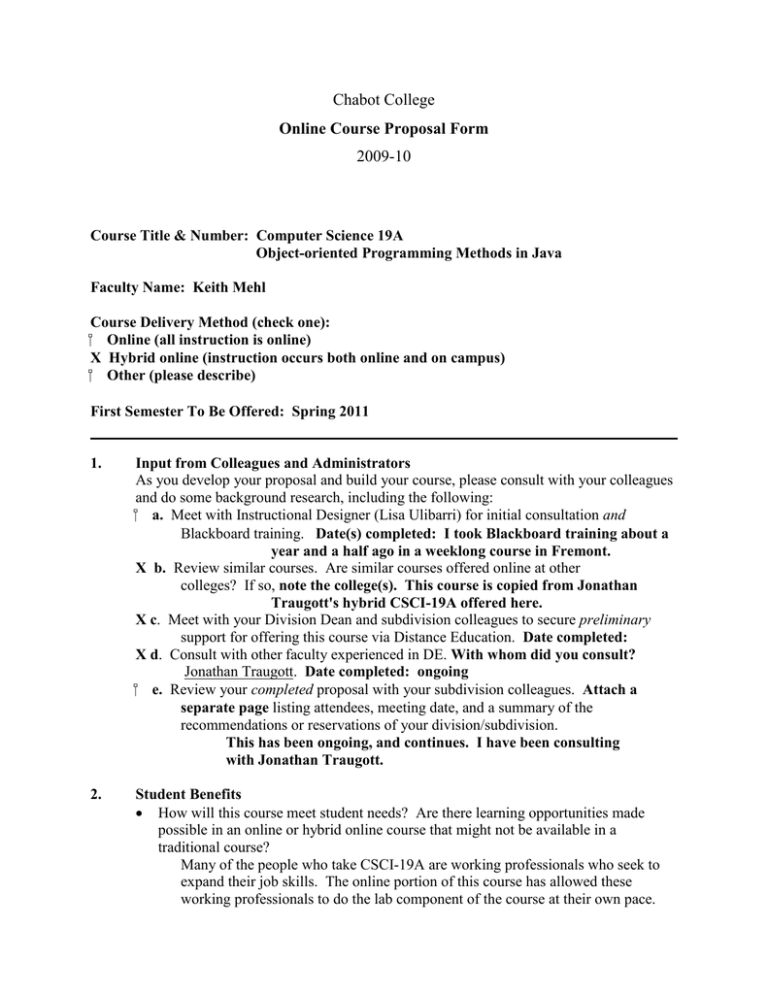
Chabot College Online Course Proposal Form 2009-10 Course Title & Number: Computer Science 19A Object-oriented Programming Methods in Java Faculty Name: Keith Mehl Course Delivery Method (check one): Online (all instruction is online) X Hybrid online (instruction occurs both online and on campus) Other (please describe) First Semester To Be Offered: Spring 2011 1. Input from Colleagues and Administrators As you develop your proposal and build your course, please consult with your colleagues and do some background research, including the following: a. Meet with Instructional Designer (Lisa Ulibarri) for initial consultation and Blackboard training. Date(s) completed: I took Blackboard training about a year and a half ago in a weeklong course in Fremont. X b. Review similar courses. Are similar courses offered online at other colleges? If so, note the college(s). This course is copied from Jonathan Traugott's hybrid CSCI-19A offered here. X c. Meet with your Division Dean and subdivision colleagues to secure preliminary support for offering this course via Distance Education. Date completed: X d. Consult with other faculty experienced in DE. With whom did you consult? Jonathan Traugott. Date completed: ongoing e. Review your completed proposal with your subdivision colleagues. Attach a separate page listing attendees, meeting date, and a summary of the recommendations or reservations of your division/subdivision. This has been ongoing, and continues. I have been consulting with Jonathan Traugott. 2. Student Benefits How will this course meet student needs? Are there learning opportunities made possible in an online or hybrid online course that might not be available in a traditional course? Many of the people who take CSCI-19A are working professionals who seek to expand their job skills. The online portion of this course has allowed these working professionals to do the lab component of the course at their own pace. 3. 4. If this course has previously been offered at Chabot using this delivery method, what have you learned from prior instructors that will influence your instruction in this course? I have consulted with Jonathan Traugott regarding his presentation of the course, and have copied much of his materials. He gave me a copy of his course Blackboard site to use as a model for my course site. I intend my presentation to match Mr. Traugott's course as closely as possible. Course Content Delivery The total number of contact hours in your course should approximate the equivalent number of hours required in an on-campus setting. For example, a 3-unit course typically meets on campus for 54 contact hours of instruction, assessment, discussion, and group activities. In the Carnegie unit system, students are also expected to invest two hours “outside of class” for every hour in class on reading, studying, preparing assignments, and other homework; these additional hours are not considered to be “contact hours”. Account for the contact hours in your proposal. (PLEASE NOTE: For a more detailed explanation of “contact hours” be sure to see the Addendum attached to this form.) All contact hours are on-campus lecture hours. What percentage of the course will be on-campus, if any? What percentage of the course will consist of online lecture, video, podcasts, email, supplemental websites, CD-ROM, etc.? All lectures will be on-campus. The laboratory component will comprise exercises, online quizzes and supplemental materials, as well as provide a mechanism (via GOAL) for students to submit homework. Will any portion of your course be synchronous, requiring students to be online at the same time? If so, describe those activities, and how you will provide flexibility for students who may be unable to participate at any given time. Student on-line activities are not scheduled synchronously. Nature and Frequency of Instructor-Student Interactions How and how frequently will you interact with your students? This should include interactions with the entire class, providing feedback on assignments, and interventions when students are at-risk of dropping or failing due to poor performance or participation. My intention is to respond to student's e-mailed questions and requests for help several times daily. I normally return quizzes and homework within a week. Students may reach me in my office hours, by telephone and by e-mail. Since we are meeting on campus each week, I will see students regularly in person. For each type of interaction, describe why you believe it will be effective for this particular course. In my on-campus courses, I normally respond to student questions in e-mail within one day, which works well. I ask for a particular format in the subject line of e-mails, for example, a subject line of CS19A Keith Mehl question on assignment 3 would tell me the course, who is sending the e-mail, and why they are e-mailing me. I respond to questions immediately on seeing "question" in the subject line. 5. Nature and Frequency of Student-Student Interactions Describe opportunities in your course for student to student interaction. This may include discussions, group projects, peer review of assignments, and other approaches. Consider how students interact in this course when taught on campus; how can you build this type of learning community online? I intend the online portion of the class to supplement the on-campus sessions, where there will be opportunity for discussion. There will be some collaborative projects where students cooperate on a project, but not much other peer-to-peer work (e.g., review, discussion). In professional programming, most work is done by programmers in groups; but, except for the design and integration phases, each programmer works alone on their part of the problem. However, for that to mean anything, the project must be quite large, which will not happen in this course. So there will not be a lot of student interaction as it doesn't mean much with this course material. 6. Assessment of Student Learning How will you assess learning in this course? Given the nature of online courses, how does your assessment plan ensure a level of academic integrity with which you’re comfortable? The major portion of the grade will be based on in-class assessments. There will be some online assessed material, but that will be a minor portion of the course grade. Describe how your assessment plan is consistent with your stated goals in the student benefits and student-student interactions sections of your proposal. How will you provide feedback to students? 7. Technology Describe any special software or multimedia tools you plan to utilize in your course (Articulate, Camtasia, Captivate, Flash, podcasts, videocasts, etc.). This is helpful to determine technology support needs. The students may use a Pearson online product called GOAL for some work. Otherwise, the tools used in the class will be Java (a free download from Sun Microsystems) and Blackboard. 8. Accommodations for Students with Disabilities Is any required video close-captioned? Is any required audio accompanied by a transcript? If you plan to use any multimedia (video, podcasts, specialized software), is that accessible to your students in terms of both software availability at home and on campus and accessible for students with disabilities? Have you provided alt-tags for your key images used in your course? Please meet with the DSRC if you need help in ensuring accessibility for your students. There will be no video of the course on-line since students will come to lecture. The course PowerPoint slides will be available on Blackboard. 9. Submit your proposal (electronic version via email and hard copy via campus mail) to the chair of the Committee on Online Learning. Faculty signature: _______________________________ Date: _______________ Division Dean signature: __________________________ Date: ________________ Online/Hybrid Proposal Form Addendum: Committee On Online Learning/Chabot College What are Actual Contact Hours? The total number of contact hours in your course should approximate the equivalent number of hours required in an on-campus setting. For example, a 3-unit course typically meets on campus for 54 contact hours of instruction, assessment, discussion, and group activities, (Note: Instructional Hours are 50 minutes long). In the Carnegie unit system, students are also expected to invest two hours “outside of class” for every hour in class on reading, studying, preparing assignments, and other homework; these additional hours are not considered to be “contact hours”. Thus, you will need to account for the actual contact hours in your proposal. In accounting for contact hours an instructor needs to consider how each hour will be dispersed throughout each week of his/her online or hybrid course. In addition, students should be expected to spend two preparatory hours “outside of class” per every contact hour. The following chart illustrates some sample activities for an online class. These are suggestions and each instructor would use whichever activities, best suited to the type of course and discipline being offered: Contact Hour or “In-class” Activities Read lectures/ content Participate in Discussion Board Forums Assessments – quizzes, tests, surveys Presentations From the Instructor View multimedia content Group Problem Solving Transformative Learning Activities in class: Responding to other learners in regard to certain questions that challenge a learner’s perspective on key issues in the course materials. Reading another Student’s Blog Posting feedback, Reading student posts, and Peer Reviewing other Student’s papers on the discussion board or group forum. Group Projects that include multiple posts to each group member within their designated group forum space. “In class” reading of short texts, scenarios or quick discussion questions. Reading another student’s presentation. (This would be the equivalent of listening and viewing a student presentation in a face-to-face class.) Constructivist Assignments that target real-life applications for class discussion on the Discussion Board. Therefore, in preparing the online or hybrid proposal an instructor will need to explain how each instructional hour will be implemented throughout each week of his/her online or hybrid course. This can be done using percentages or actual hourly increments. For example an instructor may determine that 25 percent of his/her course will offer lectures and presentations, (13.5 contact hours), while another 25 percent of the contact hours will be used in constructivist assignments or asynchronistic discussion and peer responses, (13.5 contact hours). These are the same kinds of methods of instructional contact that are often used in a face-to-face class. However, there are certain learning activities that may not meet the criteria of actual “contact hours”. This chart reflects instructional, preparatory “outside of class” activities that in some cases would not necessarily be considered actual contact hours. Preparatory or “Outside of Class” Activities Read Textbooks Research Preparing assignments Viewing an internet site for one’s own research purposes. Individual Reflective Writing Journaling Writing /Composing a Blog Analyzing another student’s ideas individually. Using a WIKI for posting ideas to other class members in preparation for a Group Project. Outside reading of additional texts pertaining to the course subject matter as homework preparation. Preparing an individual class presentation. Reviewing class notes. In summary, “contact hours” are usually those segments of instructional time where the student is actively engaged in learning activities and would reflect the same type of instruction implemented in a traditional face-to-face classroom. Therefore, instructors are encouraged to offer a clear breakdown of “contact hours” in the section of the proposal entitled, “Course Content Delivery”.
